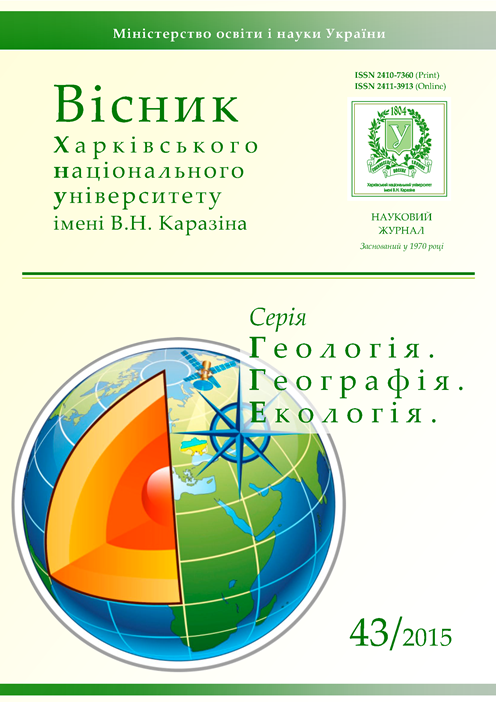Lithology and features of polymineral alluvium separation, on the example of rivers of Ukraine
Abstract
The river network is part of modern geological environment. It reflects the dynamics of natural processes and the impact of technogenic factors. Changes in the ecological condition of the environment are necessitated by the study and management of alluvium accumulated in the river network in Ukraine. Some 100 samples of alluvium in the rivers Dnieper, Pivdenniy Bug, Ingul, Ingulets and others have been studied. Optical and electron microscopy, lithological and technological researches have been used. Light fraction consists of quartz, carbonates (including organic), feldspar, kaolinite predominates in a fine grade alluvium. Heavy fraction contains almandine, ilmenite, zircon, monazite, to a lesser extent apatite, rutile. Sometimes there is gold, silver, diamonds and other rare minerals. Available particles of metallic iron, bronze, steel sludge, slag, refractories, glass and ore balls are the indicators of the anthropogenic pollution of environment. Dry separation of alluvium has been used in the laboratory. As a result we obtained concentrates of heavy minerals: garnet, ilmenite, monazite, minerals of iron. With the tailings of separation quartz, marshalit, gypsum, carbonates, clay was obtained. Separation methods of natural and contaminated sediments were different, because of the presence of industrial waste in the composition of contaminated alluvium. Researches are confirmed by a polygenic (natural and man-made) formation of high concentrations of heavy minerals in the river alluvium. Extraction of heavy minerals also has ecological significance, since it leads to the clearing of rivers from industrial wastes.
Downloads
References
2. Байсарович І.М. Базові поняття екологічної геології [Текст] / І.М. Байсарович, М.М. Коржнев, В.М. Шес-топалов. – К.: «Обрій», 2008. – 122 с.
3. Літологія і можливості використання алювію річок України [Текст] / М.В. Випна, В.В. Іванченко / Матері-али міжнар. наук.–тех. конф. «Сталий розвиток промисловості у суспільстві», 22–25 жовтня 2014, м. Кривий Ріг. – Кривий Ріг: 2014. – 77 с.
4. Геохімічна спеціалізація донних відкладів рік центральної та південної України [Текст] / М.В. Випна, В.В. Іванченко / Сб. докладов междунар. науч. конф.: «Актуальные проблемы поисковой и экологической геохи-мии», 2 июля 2014, г. Киев. – Киев, 2014. – С. 6–7.
5. Геология шельфа УССР. Литология [Текст] / Е.Ф. Шнюков, В.І. Мельник, Ю.И. Іноземцев і др. – К.: Наукова думка, 1985. – 190 с.
6. Природные и антропогенне факторы формирования химического состава донных отложений озер Севера Фенноскандии [Текст] / С.С. Сандимиров, В.А. Даувальтер, Н.А. Кашулин / Материалы VII Всероссийского совещания по изучению четвертичного периода, 12–17 сентября 2011, г. Апатиты. – Т. 1. – С. 157–160.
7. Літологія та можливості комплексного використання сучасного алювію річки Дніпро [Текст] / В.В. Іванче-нко, М.В. Беліцька, І.В. Гаврилюк // Вісник Дніпропетровського університету. – Т. 23(1), 2015 г. – С. 56–64.
8. Мінералогія донних відкладів річки Інгулець [Текст] / В.В. Іванченко, Н.Р. Журавель // Записки Українського мінералогічного товариства. – Т. 8, 2011 г. – С. 99–103.
9. Эффективная технология обогащения природных и техногенных руд / Ю.Д. Чугунов, В.В. Иванченко / «Ма-териалы 1 Междунар. науч–практ. конф. «Актуальные проблемы современной науки в 21 веке», г. Москва, 31 марта 2013. – Москва, 2013. – С. 38–41.
10. Мобільний збагачувальний агрегат. Патент України на корисну модель № 83761. [Текст] / Ю.Д. Чугунов, В.В. Іванченко. – Опубл. 25.09.2013, Бюл. № 18.
11. Aller, R. C., Mackin, J. E., & Cox, R. T. (1986). Diagenesis of Fe and S in Amazon inner shelf muds: apparent dom-inance of Fe reduction and implications for the genesis of ironstones. Continental Shelf Research, 6(1), 263–289.
12. Chugunov Y, Ivanchenko V. Technology for tnrichment and reproctssing of slag wast incineration plants. Proceed-ings of XVI Balkan Mineral Processing Congress. Belgrade, Serbia, June 17–19, 2015. – V. II. – P. 859–860.
13. Hrasna M. Environmental Geology – the new branch of geologic sciences. Acta Geologaca Iniv / Com., Bratislava, 1999. – Nr. 54. – P. 66–68.
14. Ivanchenko V.V., Belitskaya M.V. and Ilyina A.S. Features of geochemistry and mineralogy of the modern river sedimentogenesis. 2015 Goldschmidt Conference, 16–21 August 2015, Prague, Czech Republic. – P. 1395.
15. Kovalchuk M.S. The morphology and chemical composition peculiarities of native gold from sedimentary complexes of Ukrainian // Geological journal. – 1999. – № 2. – С. 60 – 67.
16. Kovalchuk M.S. The morphological of gold from heteroaged sedimentary complexes of Ukrainian Carpathians // Geologica Carpathica (Procedings of the XVII. Congress of Carpathian–Balkan Geological Association. – Brati-slava, September 1th–4 Th.2002). – Vol. 53. –P. 2002.
17. Lokhande, R. S., Singare, P. U., & Pimple, D. S. (2011). Pollution in water of Kasardi River flowing along Taloja industrial area of Mumbai, India. World Environment, 1(1), 6–13.
18. Mohiuddin, K. M., Zakir, H. M., Otomo, K., Sharmin, S., & Shikazono, N. (2010). Geochemical distribution of trace metal pollutants in water and sediments of downstream of an urban river. International Journal of Environmental Science & Technology, 7(1), 17–28.
19. Pan, B., Wu, G., Wang, Y., Liu, Z., & Guan, Q. (2001). Age and genesis of the Shagou River terraces in eastern Qi-lian Mountains.Chinese Science Bulletin,46(6). – P. 509–513.
20. Sherstuk N.P. Evaluation of migration microelements in rivers water Saksagan and Ingulets. Dnipropetrovsk Uni-versity bulletin. Serias: Geolody, geography. 2015. – 23(1). – P. 144–152 (in Russian).
21. Singare, P.U., Lokhande, R.S., & Jagtap, A. G. (2010). Study of physico–chemical quality of the industrial waste water effluent from Gove industrial area of Bhiwandi City of Maharashtra, India. Interdisciplinary Environmental Review. 11(4)/ – P. 263–273.
22. Sklar, L. S., Dietrich, W. E. (2001). Sediment and rock strength controls on river incision into bedrock. Geology, 29(12). – P. 1087–1090.
23. Trimble, S. W. (1999). Decreased rates of alluvial sediment storage in the Coon Creek Basin, Wisconsin, 1975–93. Science, 285(5431), 1244–1246.
24. Wang, Mark, et al. Rural industries and water pollution in China. Journal of Environmental Management, 2008, 86.4: 648–659.
25. Yang, S.Y., Jung, H.S., Choi, M.S., & Li, C.X. (2002). The rare earth element compositions of the Changjiang (Yangtze) and Huanghe (Yellow) river sediments. Earth and Planetary Science Letters, 201(2). – P. 407–419.





